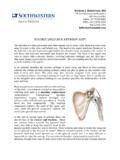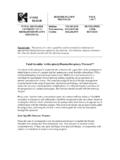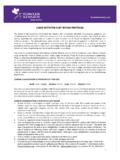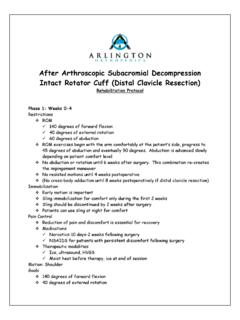Transcription of Rehabilitation after total shoulder arthroplasty
1 William J. Robertson, MD. TMI Sports Medicine 3533 Matlock Rd Arlington, TX 76015. Office: (817) 419-0303. Fax: (817) 468-5963. shoulder arthroplasty . The shoulder is a ball and socket joint that enables you to raise, twist, bend and move your arms forward, to the sides and behind you. The head of the upper arm bone ( humerus) is the ball and a circular depression (glenoid) in the shoulder bone (scapula) is the socket. A. soft tissue rim (labrum) surrounds and deepens the socket. The head of the upper arm bone is coated with a smooth, durable, covering (articular cartilage) and the joint has a thin, inner lining (synovium) for smooth movement. The surrounding muscles and tendons provide stability and support.
2 Many people know someone with an artificial knee or hip joint. Less common, but just as successful in relieving joint pain is a shoulder replacement ( arthroplasty ). This procedure may be recommended if arthritis or degenerative joint disease makes your shoulder stiff and painful, or if the upper arm bone is fractured so badly that tissue death may result. shoulder replacement surgery replaces damaged joint surfaces with artificial parts (prostheses). Usually there are two components: The humeral component replaces the head of the upper arm bone. It is made of metal (usually cobalt/ chromium-based alloys) and has a rounded ball attached to a stem that fits into the bone.
3 This component comes in various sizes and is a modular unit. The glenoid component replaces the socket (the glenoid depression). It is made of an ultra - high density polyethylene (plastic). Depending on the damage to your shoulder , you may have just the humeral head replaced (hemiarthroplasty) or both the humeral head and the glenoid replaced ( total shoulder replacement). The components are held in place with either acrylic bone cement (cemented) or rely on bone ingrowth (press fit, or cementless). As in the native joint, the surrounding muscles and tendons provide stability for the prosthesis. Rehabilitation after total shoulder arthroplasty .
4 The risks of the surgery include but are not limited to: Infection Instability of the joint replacement Fracture of either the humerus or glenoid bone Nerve injury Loosening of the joint replacement Anesthesia problems Hematoma or blood clots Postoperative Instructions You will wake up in the operating room with a sling in place. You will go to the recovery room and then be transferred to your hospital room after a few hours. You can get out of bed when you wish. You should continue to apply ice to your shoulder to re duce pain and swelling. (An ice machine that circulates cold water to the shoulder may be applied in the operating room). pain is usually controlled for the first 18-36 hours via a regional anesthetic nerve block.
5 With catheter and pump that will slowly trickle in medication. While the block is in effect, the operative hand and arm will usually be completely numb. Afterwards you will be transitioned to oral pain medications such as hydrocodone. While a blood transfusion is rare, it is occasionally necessary. You may be discharged home on either the first or second postoperative day. You will need someone to assist you at home, so family should be aware that you will need help with simple daily living chores such as dressing, cooking, and feeding your self. Upon discharge from the hospital you will visit a TMI Physical Therapist in Dr. Robertson's office, where they will begin the post-operative therapy program, show you some exercises for home, and change your bandage if necessary.
6 Rehabilitation after total shoulder arthroplasty . Activities and advice for in the hospital and while at home: 1. Please call with any concerns: (817) 419-0303. 2. Apply ice, or the cooling unit, to the shoulder as it will be quite helpful. after two days, you can change the dressing to a smaller one to allow the cold to better get to the shoulder . Once the incision is dry, another dressing is not necessary. 3. Remove the sling on the first day after surgery. Move your elbow, wrist, hand and fingers several times a day. Begin the pendulum exercises several times a day. Pu t the sling back on when you're done with these exercises. 4. after two days it is okay to shower but do not get the wound wet for at least two weeks after surgery.
7 Do not submerge the wound as you would in a bath tub or hot tub for at least 4 weeks after surgery. To wash under your operated arm bend over at the waist and let the arm passively swing away from the body. It is safe to wash under the arm in this position. 5. after shoulder surgery there is a variable amount of pain and swelling. This will dissipate after several days. Continue to take the pain medicine you were prescribed as needed. Remember it is called pain control, not pain elimination. 6. It is important to look out for signs of infection following joint replacement surgery. These can include: fever (temperature > 0, chills, nausea, vomiting, diarrhea, redness around your incision, or yellow or green drainage from your incision.)
8 Should any of these be present please contact Dr. Robertson's office immediately. 7. You will need to take prophylactic antibiotics before dental procedures, colonoscopies or other invasive procedures. This consists of Amoxicilin (2. grams one hour prior to your procedure), or if you have a penicillin allergy you should take Clindamycin (600mg one hour prior to procedure). Your dentist or Dr. Robertson can prescribe this. 8. You will have another office visit scheduled for approximately 10-14 days after your surgery. Rehabilitation after total shoulder arthroplasty . Rehabilitation after total shoulder arthroplasty . Phase I: 0-6 weeks after surgery (may progress to Phase II when criteria met).
9 Goals: 1. Protect the shoulder arthroplasty 2. Ensure wound healing 3. Prevent shoulder stiffness Precautions: 1. Protect subscapularis repair for the first 4 weeks. No external rotation beyond 30 in scaption for the first 4 weeks. Activities: 1. Use your sling during this period. When you are at home and not moving it is okay to come out of the sling as long as you are careful and keep the shoulder safe. Your elbow should be tucked in to your side whenever you are out of your sling. Put the sling on when you are outside or in a crowd. Keep the sling on when sleeping at night for the first 4 weeks. 2. You may use the hand on your operated arm as long as you do not rotate your shoulder away from your body.
10 You should bend your arm at the elbow and use your fingers and hand such as to reach up and touch your face. Keep your elbow in front of you. 3. You may shower as previously described. Do not submerge the wound under water. 4. Begin the phase one exercises. Supine exercises should be done with a small rolled towel placed behind the elbow to avoid shoulder hyperextension and anterior capsular stretch. 5. Continue to use your ice or cooling system: 7 days per week, 4-5 times per day, 15- 20 minutes per time Rehabilitation after total shoulder arthroplasty . Exercises: ALL EXERCISES SHOULD BE DONE SLOWLY TO MAXIMIZE MUSCLE AND SOFT TISSUE. INVOLVEMENT.











